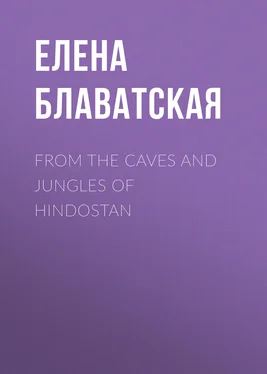Елена Блаватская - From the Caves and Jungles of Hindostan
Здесь есть возможность читать онлайн «Елена Блаватская - From the Caves and Jungles of Hindostan» — ознакомительный отрывок электронной книги совершенно бесплатно, а после прочтения отрывка купить полную версию. В некоторых случаях можно слушать аудио, скачать через торрент в формате fb2 и присутствует краткое содержание. Жанр: Путешествия и география, История, foreign_edu, foreign_antique, foreign_prose, на английском языке. Описание произведения, (предисловие) а так же отзывы посетителей доступны на портале библиотеки ЛибКат.
- Название:From the Caves and Jungles of Hindostan
- Автор:
- Жанр:
- Год:неизвестен
- ISBN:нет данных
- Рейтинг книги:5 / 5. Голосов: 1
-
Избранное:Добавить в избранное
- Отзывы:
-
Ваша оценка:
- 100
- 1
- 2
- 3
- 4
- 5
From the Caves and Jungles of Hindostan: краткое содержание, описание и аннотация
Предлагаем к чтению аннотацию, описание, краткое содержание или предисловие (зависит от того, что написал сам автор книги «From the Caves and Jungles of Hindostan»). Если вы не нашли необходимую информацию о книге — напишите в комментариях, мы постараемся отыскать её.
From the Caves and Jungles of Hindostan — читать онлайн ознакомительный отрывок
Ниже представлен текст книги, разбитый по страницам. Система сохранения места последней прочитанной страницы, позволяет с удобством читать онлайн бесплатно книгу «From the Caves and Jungles of Hindostan», без необходимости каждый раз заново искать на чём Вы остановились. Поставьте закладку, и сможете в любой момент перейти на страницу, на которой закончили чтение.
Интервал:
Закладка:
In a short time the Theosophical Society counted its members, not by hundreds, but by thousands. All the "malcontents" of American Spiritualism—and there were at that time twelve million Spiritualists in America—joined the Society. Collateral branches were formed in London, Corfu, Australia, Spain, Cuba, California, etc. Everywhere experiments were being performed, and the conviction that it is not spirits alone who are the causes of the phenomena was becoming general.
In course of time branches of the Society were in India and in Ceylon. The Buddhist and Brahmanical members became more numerous than the Europeans. A league was formed, and to the name of the Society was added the subtitle, "The Brotherhood of Humanity." After an active correspondence between the Arya-Samaj, founded by Swami Dayanand, and the Theosophical Society, an amalgamation was arranged between the two bodies. Then the Chief Council of the New York branch decided upon sending a special delegation to India, for the purpose of studying, on the spot, the ancient language of the Vedas and the manuscripts and the wonders of Yogism. On the 17th of December, 1878, the delegation, composed of two secretaries and two members of the council of the Theosophical Society, started from New York, to pause for a while in London, and then to proceed to Bombay, where it landed in February, 1879.
It may easily be conceived that, under these circumstances, the members of the delegation were better able to study the country and to make fruitful researches than might, otherwise, have been the case. Today they are looked upon as brothers and aided by the most influential natives of India. They count among the members of their society pandits of Benares and Calcutta, and Buddhist priests of the Ceylon Viharas—amongst others the learned Sumangala, mentioned by Minayeff in the description of his visit to Adam's Peak—and Lamas of Thibet, Burmah, Travancore and elsewhere. The members of the delegation are admitted to sanctuaries where, as yet, no European has set his foot. Consequently they may hope to render many services to Humanity and Science, in spite of the illwill which the representatives of positive science bear to them.
As soon as the delegation landed, a telegram was despatched to Dayanand, as everyone was anxious to make his personal acquaintance. In reply, he said that he was obliged to go immediately to Hardwar, where hundreds of thousands of pilgrims were expected to assemble, but he insisted on our remaining behind, since cholera was certain to break out among the devotees. He appointed a certain spot, at the foot of the Himalayas, in the jab, where we were to meet in a month's time.
Alas! all this was written some time ago. Since then Swami Dayanand's countenance has changed completely toward us. He is, now, an enemy of the Theosophical Society and its two founders—Colonel Olcott and the author of these letters. It appeared that, on entering into an offensive and defensive alliance with the Society, Dayanand nourished the hope that all its members, Christians, Brahmans and Buddhists, would acknowledge His supremacy, and become members of the Arya Samaj.
Needless to say, this was impossible. The Theosophical Society rests on the principle of complete non-interference with the religious beliefs of its members. Toleration is its basis and its aims are purely philosophical. This did not suit Dayanand. He wanted all the members, either to become his disciples, or to be expelled from the Society. It was quite clear that neither the President, nor the Council could assent to such a claim. Englishmen and Americans, whether they were Christians or Freethinkers, Buddhists, and especially Brahmans, revolted against Dayanand, and unanimously demanded that the league should be broken.
However, all this happened later. At the time of which I speak we were friends and allies of the Swami, and we learned with deep interest that the Hardwar "mela," which he was to visit, takes place every twelve years, and is a kind of religious fair, which attracts representatives from all the numerous sects of India.
Learned dissertations are read by the disputants in defence of their peculiar doctrines, and the debates are held in public. This year the Hardwar gathering was exceptionally numerous. The Sannyasis—the mendicant monks of India—alone numbered 35,000 and the cholera, foreseen by the Swami, actually broke out.
As we were not yet to start for the appointed meeting, we had plenty of spare time before us; so we proceeded to examine Bombay.
The Tower of Silence, on the heights of the Malabar Hill, is the last abode of all the sons of Zoroaster. It is, in fact, a Parsee cemetery. Here their dead, rich and poor, men, women and children, are all laid in a row, and in a few minutes nothing remains of them but bare skeletons. A dismal impression is made upon a foreigner by these towers, where absolute silence has reigned for centuries. This kind of building is very common in every place were Parsees live and die. In Bombay, of six towers, the largest was built 250 years ago, and the least but a short time since. With few exceptions, they are round or square in shape, from twenty to forty feet high, without roof, window, or door, but with a single iron gate opening towards the East, and so small that it is quite covered by a few bushes. The first corpse brought to a new tower—"dakhma"—must be the body of the innocent child of a mobed or priest. No one, not even the chief watcher, is allowed to approach within a distance of thirty paces of these towers. Of all living human beings "nassesalars"—corpse-carriers—alone enter and leave the "Tower of Silence." The life these men lead is simply wretched. No European executioner's position is worse. They live quite apart from the rest of the world, in whose eyes they are the most abject of beings. Being forbidden to enter the markets, they must get their food as they can. They are born, marry, and die, perfect strangers to all except their own class, passing through the streets only to fetch the dead and carry them to the tower. Even to be near one of them is a degradation. Entering the tower with a corpse, covered, whatever may have been its rank or position, with old white rags, they undress it and place it, in silence, on one of the three rows presently to be described. Then, still preserving the same silence, they come out, shut the gate, and burn the rags.
Amongst the fire-worshippers, Death is divested of all his majesty and is a mere object of disgust. As soon as the last hour of a sick person seems to approach, everyone leaves the chamber of death, as much to avoid impeding the departure of the soul from the body, as to shun the risk of polluting the living by contact with the dead. The mobed alone stays with the dying man for a while, and having whispered into his ear the Zend-Avesta precepts, "ashem-vohu" and "Yato-Ahuvarie," leaves the room while the patient is still alive. Then a dog is brought and made to look straight into his face. This ceremony is called "sas-did," the "dog's-stare." A dog is the only living creature that the "Drux-nassu"—the evil one—fears, and that is able to prevent him from taking possession of the body. It must be strictly observed that no one's shadow lies between the dying man and the dog, otherwise the whole strength of the dog's gaze will be lost, and the demon will profit by the occasion. The body remains on the spot where life left it, until the nassesalars appear, their arms hidden to the shoulders under old bags, to take it away. Having deposited it in an iron coffin—the same for everyone—they carry it to the dakhma. If any one, who has once been carried thither, should happen to regain consciousness, the nassesalars are bound to kill him; for such a person, who has been polluted by one touch of the dead bodies in the dakhma, has thereby lost all right to return to the living, by doing so he would contaminate the whole community. As some such cases have occurred, the Parsees are trying to get a new law passed, that would allow the miserable ex-corpses to live again amongst their friends, and that would compel the nassesalars to leave the only gate of the dakhma unlocked, so that they might find a way of retreat open to them. It is very curious, but it is said that the vultures, which devour without hesitation the corpses, will never touch those who are only apparently dead, but fly away uttering loud shrieks. After a last prayer at the gate of the dakhma, pronounced from afar by the mobed, and re-peated in chorus by the nassesalars, the dog ceremony is repeated. In Bombay there is a dog, trained for this purpose, at the entrance to the tower. Finally, the body is taken inside and placed on one or other of the rows, according to its sex and age.
Читать дальшеИнтервал:
Закладка:
Похожие книги на «From the Caves and Jungles of Hindostan»
Представляем Вашему вниманию похожие книги на «From the Caves and Jungles of Hindostan» списком для выбора. Мы отобрали схожую по названию и смыслу литературу в надежде предоставить читателям больше вариантов отыскать новые, интересные, ещё непрочитанные произведения.
Обсуждение, отзывы о книге «From the Caves and Jungles of Hindostan» и просто собственные мнения читателей. Оставьте ваши комментарии, напишите, что Вы думаете о произведении, его смысле или главных героях. Укажите что конкретно понравилось, а что нет, и почему Вы так считаете.












